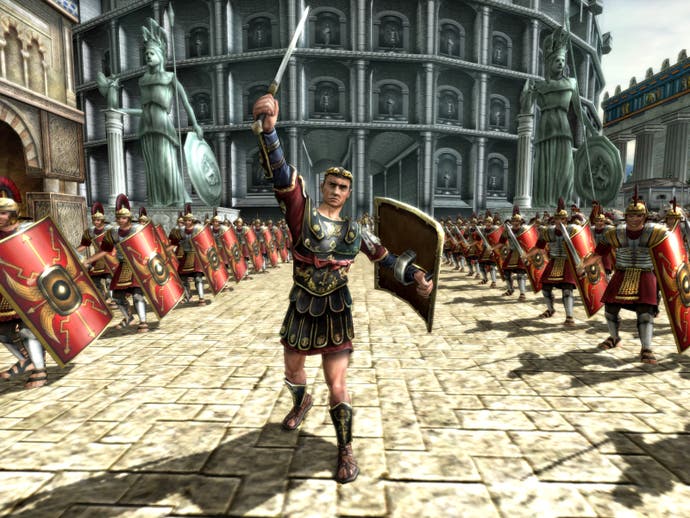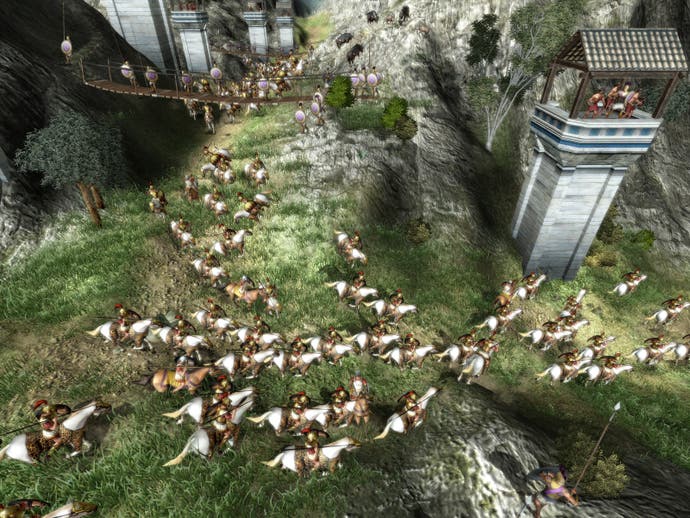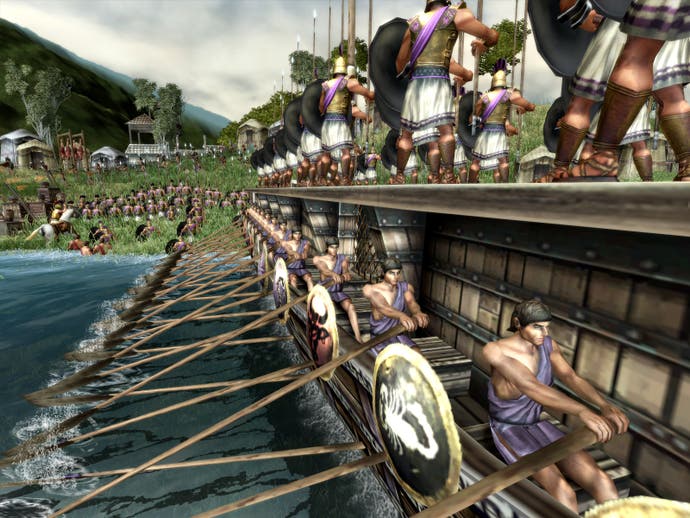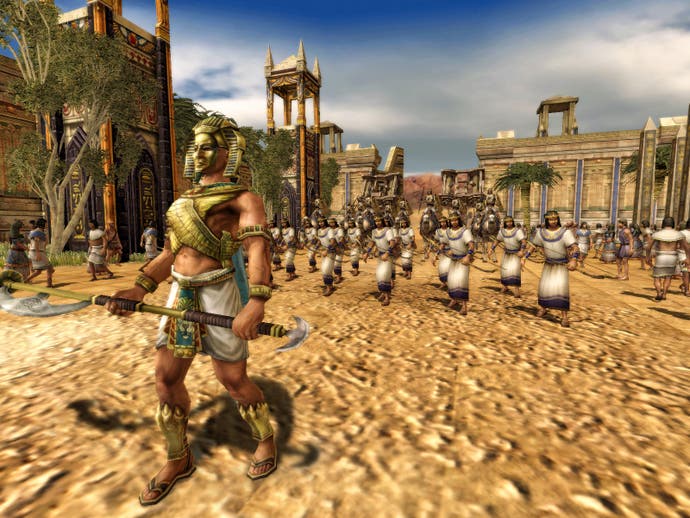Rise & Fall: Civilizations At War
Ziggy played guitar. Also, RTS.
When Preview code arrives in the dread palace of Eurogamer, it's our first chance to really see behind the PR curtains and get a real impression of what's to come. Let's take that first impression thing literally. Here's the rise and fall of thoughts as Rise & Fall entered my consciousness, virtually unfiltered except for all the times when I stared into the middle-distance and thought of evil things involving pretty girls.
1) Open the parcel. Inside it is a DVD (implying that there's more content than can comfortably fit on a traditional disc), a manual (implying that it's the sort of game that actually requires the manual, since PR doesn't normally include one if it doesn't) and a serial code (which implies that I'm going to have to go through some a tedious rigmarole of typing numbers). As I head back from the post-office, I flick through the manual. Dramatic cover art, especially for an RTS. One line on the first page is blocked out in a box-out: "Rise and Fall is the only RTS that puts you in the armour of a general fighting side-by-side with your troops in history's most massive battles." I'll be sure to keep an eye out for that then.
2) Install and boot the game up. Fairly standard intro sequence. Single-player mode includes two separate campaigns, as well as the option to play custom campaigns, single missions and tutorials. Multiplayer games elsewhere. All fairly standard RTS options seem to be visible. Presentation wise, it's efficient but doesn't distance itself from any of its peers. While it may have innovations, it doesn't want to alienate RTS games immediately by throwing them into something unfamiliar. This is, as I continue, a reoccurring trend.

3) Start to play Alexander's campaign. Initial thing that hits you is... well, the graphics. First impression is always a visual one and here Rise and Fall is... perfectly acceptable. We're immediately dropped into a Macedonian City that's under siege, and rendered impressively. Catapults crash against the walls, eventually causing them to fall away. We see bits of physics come into play, in the manner of Age of Empires III. In the next mission, for example, we see the enemy roll stones down a hill toward our armies. Were you to be picky, you'd note the general art design doesn't seem to be up to the levels of (say) Rise of Legends, nor does it appear to have achieved the character of Dawn of War, but there's nothing openly embarrassing. Higher than mid-table.
4) Second thing is its pacing. While we haven't played the tutorial, the game's chosen a less complicated start. However, rather than a less complicated start that's terribly dull, they've done it in a more exciting level. The siege has mass armies involved, but doesn't actually involve anything too immediately challenging. It's the second level where things are scaled back a little, and you're introduced to the game's economics, and only at its close do we get to the more unique features. But we'll get to there in a few points. Hold onto your feathered helmets.
5) Third thing is that even at this point some of the more interesting, differing mechanisms appear. While units are created in small groups of three or so, much like most RTS games', and are manoeuvrable individually, in practice any soldiers who are generated close together automatically huddle into a "formation" you can order around. This immediately makes things more manageable than usual - and becomes even more important when it's revealed that the larger a formation of soldiers, the bigger the combat bonus they get. It's a streamlined and efficient mechanism. Hurrah.

6) Onwards to the second and third missions and more details are revealed. The economic side, for example, is highly traditional. Citizens work as standard peons, gathering the two main resources, Wood and Gold. A third resource is gathered by gaining settlements, linking to your army's abilities. Most interesting is Glory, which is gained by your achievements in construction and destruction. You spend this on upgrades for your team, including advisors, each of which offers unique bonuses. Or, for the big Glory points, you can level up your hero.
7) And we reach the heroes, which are the game's core innovation. Heroes gain stamina as they progress, activated with a canny-double-click. You move into a third-person perspective behind your leader, in the middle of the melee - from Age of Empires to Spartan: Total Warrior with a button press. There, for as long as the stamina lasts, you're able to hack and slay with abandon using both close and ranged attacks. You're a one-man army, essentially, and timing when to use it is of paramount importance. In total there are eight of these heroes promised in the final game, each with their own abilities. Playing it is genuinely devastating, and while not fluid enough to seduce a hardened beat-'em-up expert, the context adds a lot to it. It'll be intriguing to see how gamers respond to Rise & Fall: strategy-action hybrids such as this - outside of a modern warfare context - have tended to be overlooked in the marketplace, if loved financially... But this is a hell of a lot closer to a traditional strategy game than (say) the divine Sacrifice. It's an addition to the RTS pantheon rather than a true attempt to hybridise it.

8) On the third level, we get another innovation, one that you suspect more RTS people will take inspiration from than the direct-control aspect: the Fleet battles. They've actually gone and made something that seems to work - or at least something that seems to work far better than anyone else's attempts. Those of you who wept as the ships in Battle for Middle-Earth 2 twitched, as though in the grip of a grand mal seizure, as you tried to work out how to land on a open stretch of beach while your army was slowly slaughtered, will be grateful. Click where they go. Board. Get off again. Ships can be ordered to ram or - even better - have sailors with grapples drag them beside each other to allow proper boarding attacks from your deckfuls of tooled up Spartans, even capturing the ship. They're also used as a portable barracks for the less specialised types, which is handy for proper beachhead attacks. Hurrah. Similarly, if less uniquely, Siege warfare is a little more developed, with wall-climbing crews and battering rams facing up against boiling oil and enormous grappling claws mounted on the wall. Hurrah again!
9) Then we hit level four, which is set entirely at sea with you playing as the hero for the entire length of a game. It's essentially someone trying to do one of the Call of Duty car-ride rollercoaster sections, but in an RTS engine. It's not entirely convincing, and the sort of thing that you suspect could even be dropped from the campaign at the last minute. A change may be as good as a rest, but it really does depend what the change is too.

10) At which point we stop playing this demo code and head to the pub. After John Walker does an impressively obscene joke involving a clitoris - and the boy's a Christian! - conversation turns to Rise & Fall. I ask around what other people who've played the code make of it. One bright chap notes that he thinks the limited direct-control time hero control's actually a master-stroke. There reaches a moment in any RTS game where you realise that you've won and it's just another five or ten minutes of tedious mopping up. Here, it's at this point you actually spend your remaining stamina and just purge the enemy from the table in a blitzkrieg of heroic slaughter. It, essentially, adds a climax to the RTS level when often that's the one thing the genre has always had trouble with.
It's a good argument, actually. Let's hope it works more like that.
11) I write it all up in a list format, find screenshots and post it to EG.
12) Actually, I clearly haven't as I've written a point 12. Concept piece broken. Internal contradictions mounting. Universe trembles. Existence perishes. Reality fails. Everyone! Run! Run to the comments thread to take cover! Deliver us, Messiah. Your people are lost without you.
Rise & Fall: Civilizations At War is due out in June.

